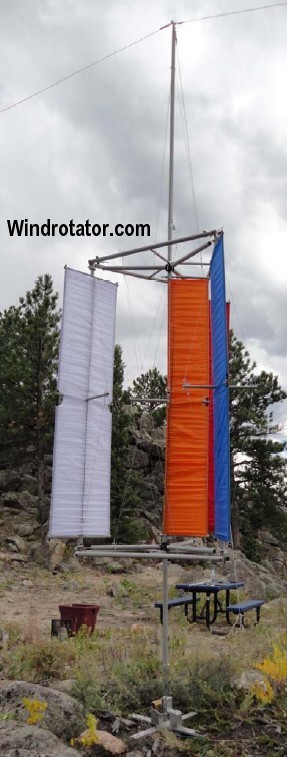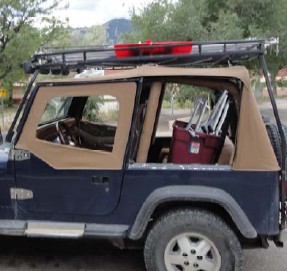 Windrotator™ is a highly efficient wind energy generator. It mimics the way sailboats adjust their sails to optimize their speed in line with their angle on the wind.
Windrotator™ is a highly efficient wind energy generator. It mimics the way sailboats adjust their sails to optimize their speed in line with their angle on the wind.Similarly, Windrotator™ adjusts the position of its tall vertical rectangular airfoils to optimize the speed at which it rotates and thus generates electricity.
Invented by Dr. Jacques Mettes, Windrotator™ can achieve efficiencies as high as 28.3%. Capacity factors around 60% can be achieved by stacking basic airfoils up to 50-100 m.
Since wind speed increases logarithmically with height, conventional wind turbines aren't very suitable for use in backyards, where height is typically restricted by council regulations.
Because of its low cost and high efficiency, Windrotator™ can generate significant amounts of electricity even at low heights and at low wind velocity, making it very suitable for use in backyards.
Suitable for use in developing nations
The photos below show a mechanical prototype that is easy to transport and set up, and can be manufactured from parts that can be easily obtained locally.

If - over time - the airfoils get out of sync with their optimal relative position, they can be manually adjusted. As the above image shows, the shaft holding the wheel in place can be shifted slightly to loosen the wheel and realign the airfoils.
This low-tech implementation make Windrotator™ especially suitable for use in developing nations.
Further versions
Further Windrotator™ implementations are under development, such as:
- A more sophisticated version features small brushless DC servo motors rotating the vertical airfoils, with sensors in the airfoils calibrating their position to trigger speed adjustments of the motors.
- Windrotator™ can also be deployed on deck of a boat, generating both kinetic power and electricity to propel the boat, as well as to power on-board equipment.
- Windrotator™ is easily transportable and can be taken along on camping trips. When stored in a battery, the generated electricity is available on demand around the clock.
 |  Dr. Mettes setting up a windrotator prototype. Below: the windrotator is easily transportable.  Images used with permission, Images used with permission,photo credit: windrotator.com |
Windrotator™ and electric vehicles complement each other
Such a micropower generator can supply power to charge the battery of your electric vehicle and, from there, to power your home.
Wind doesn't blow continuously, while more wind blows at night (when there's little or no need for electricity) than during the day. That makes it a good idea to store wind energy in a battery pack, preferably inside an electric vehicle -- a safe and secure place to keep the batteries that can also provide for your transport needs.From the car battery, electricity can then be drawn on demand for domestic use during the day and in the evening. Since they can be relatively small, you can easily put one or more of these devices in your backyard. Since they're transportable, you can also take them with you on a camping trip.
Potentially, such devices can provide all the power you need at home, for your transport and when you go on a camping trip. That can save you a lot of money on electricity and gasoline, while they can additionally feed surplus power into the grid and make money for you.
Summary
Such micropower generators:
- Can be made and maintained locally, creating local jobs and investment.
- Need no fuel, needing no drilling, mining, transport or securing of fuel supply.
- Create no emissions, improving health, environment, traffic safety (smog, etc).
- Are small and can be installed on smaller properties (Council restrictions).
- Can make the grid more reliable, secure and robust (they are numerous, and
if a generator fails or there's no wind or sun, a building has EV or grid power). - Can store power in electric vehicles (EVs), for use whenever needed locally.
- Are more efficient (they generate and use power locally, bypassing the grid).
- Save money on electricity and gasoline, and earn by selling surplus to the grid
(the grid may source power cheaper, end-consumers pay over $0.10/kWh). - Can feed surplus power into the grid as needed, prices set by supply/demand
(allowing many EVs to be rapidly recharged, even at times of peak demand). - Can charge EVs faster than the grid can (110V can be quite a bottleneck).
All rights reserved - Copyright © 2010 - Windrotator™ - Patent pending.
No comments:
Post a Comment